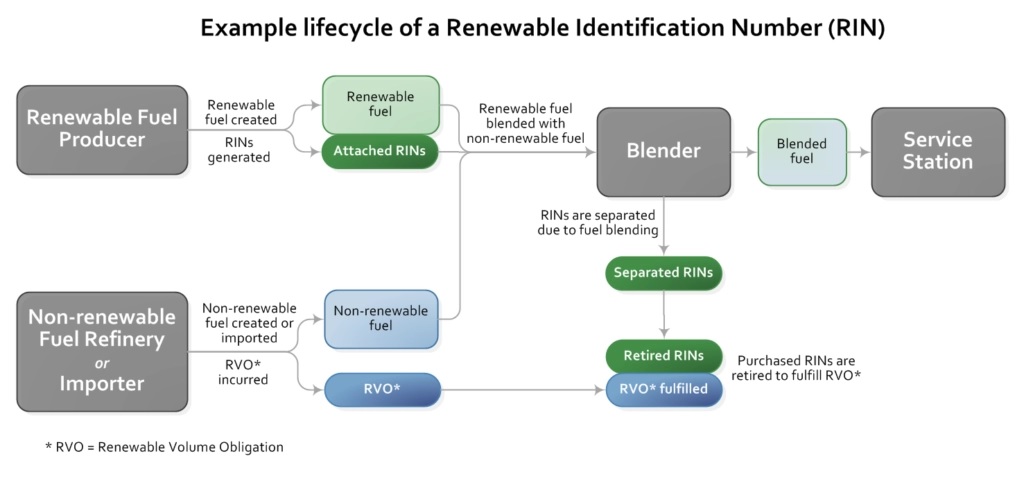WHAT ARE RENEWABLE IDENTIFICATION NUMBERS?
Renewable Identification Numbers (RINs) are credits that were created as part of the Renewable Fuel Standard (RFS), a program that aims to reduce greenhouse gas (GHG) emissions and expand the United States’ renewable fuels sector.1
In accordance with the RFS, obligated parties (refiners or importers of gasoline or diesel fuel) are required to meet a Renewable Volume Obligation (RVO) that is set annually by the Environmental Protection Agency (EPA). To demonstrate compliance with the RVO, obligated parties can either blend renewable fuels, such as renewable natural gas (RNG), into transportation fuels or obtain RINs. RINs are a tradeable commodity that can be bought attached to renewable fuels or in the market by obligated parties. RINs are typically retired for compliance by obligated parties based on their RVO after the end of the compliance year. Those RINs not retired for compliance can be carried over to the next compliance year.
ABOUT THE RENEWABLE FUEL STANDARD
The Renewable Fuel Standard program is a national policy, authorized under the Energy Policy Act of 2005 and further expanded under the Energy Independence and Security Act of 2007that requires a certain volume of renewable fuel to be blended with petroleum-based transportation fuel, heating oil or jet fuel.1 The EPA determines which fuels are eligible to qualify as renewable fuel under the RFS program. Among other requirements, fuels must achieve a reduction in greenhouse gas emissions as compared to a 2005 petroleum baseline.
Renewable fuels and their associated RINs fall into four categories based on the feedstock used, fuel type produced, energy inputs and GHG reduction thresholds, among other requirements.
- D3 – Cellulosic Biofuel
- D4 – Biomass Based Diesel
- D5 – Advanced Biofuel
- D6 – Renewable fuel
 RENEWABLE NATURAL GAS & RINS
RENEWABLE NATURAL GAS & RINS
RNG produces D3 RINs when it used as a transportation fuel in the form of liquefied natural gas or compressed natural gas. In addition to helping organizations improve their environmental impact, leveraging RNG and the RINs generated from it offer commercial opportunities. Economically, D3 RINs have a significant revenue upside, and as of April 2022, are trading at more than $3/gallon. RIN prices are driven by the U.S. economy’s shift towards natural gas with its associated reduction in carbon emissions, and being a cheaper alternative to diesel.3
DRIVE YOUR ESG GOALS WITH RNG AND RINS
With priority growing for organizations to reduce emissions and advance their environmental, social, and governance initiatives, it is imperative for companies to take action today. Renewable natural gas offers environmental benefits and is a readily available energy solution. RNG production has been accelerating but is being outpaced by the demand for it. As a leading RNG developer and solutions provider, Kinetrex Energy maximizes environmental and economic value.
Sources
- https://www.epa.gov/renewable-fuel-standard-program
- https://afdc.energy.gov/laws/RIN.html
- https://www.epa.gov/fuels-registration-reporting-and-compliance-help/rin-trades-and-price-information
- Image: https://www.pexels.com/photo/asphalt-auto-blur-cars-417018/

